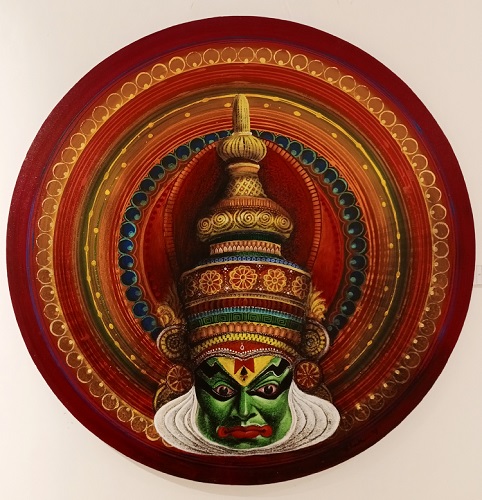
Kathakali - Acrylic Painting on canvas - 36x36 inch
ARTIST - PALASH HALDAR
TITLE - KATHAKALI
Kathakali (Malayalam: കഥകളി) is a major form of classical Indian dance. It is a "story play" genre of art, but one distinguished by the elaborately colorful make-up, costumes and face masks that the traditionally male actor-dancers wear.
Kathakali comes from southwestern India, around the state of Kerala. Like bharatanatyam, kathakali is a religious dance. It draws inspiration from the Ramayana and stories from Shaiva traditions.
Specifically, the origins of Kathakali dance date back to the late 16th and early 17th century in India. At that time, it was given its present name and took on its modern-day characteristics. ... Eventually, it is believed that both types of dances evolved into Kathakali in the region of Kerala, India.
In Kathakali, Vesham portrays archetypal characters, and hence several hours are dedicated exclusively for the make-up of the artists. The five major Veshams in Kathakali are Kathi (Knife), Pacha (Green), Thaadi (Beard), Minukku (radiant) and Kari (Black).
Father of Kathakali - Padmanabhan Nair
Early life. Padmanabhan Nair was born on 7 October 1928 in Kuruvattoor near the Kathakali village of Vellinezhi in the erstwhile Valluvanad territory, now in Palakkad district. After primary schooling, he joined Kalamandalam when he was ten years old.
Kathakali has a long tradition. It dates back to the 17th century. It was given its present form by Mahakavi Vallathol Narayan Menon, who was the founder of the Kerala Kala Mandalam.
Kathakali is a ritualistic dance-drama of Vedic age origin. In Kathakali the story is enlivened in the dance.
-
Make-up in Kathakali
-
Green denotes godliness,
-
white denotes spirituality,
-
red denotes turmoil,
-
black denotes evil and.
-
yellow denotes combination of godliness and turmoil.